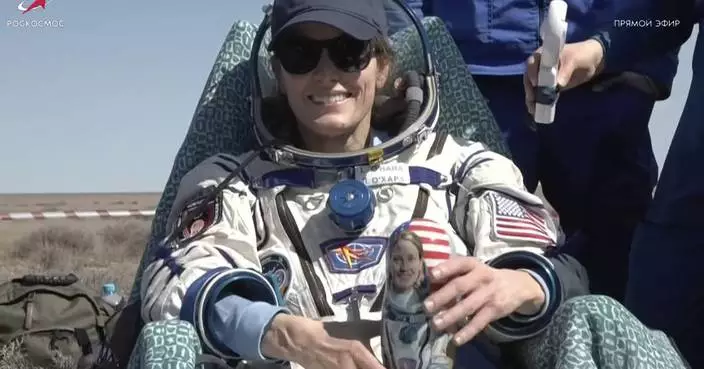NASA's record-breaking astronaut, Peggy Whitson, retired Friday less than a year after returning from her last and longest spaceflight.
She's spent more time off the planet than any other American: 665 days over three space station missions. She's also the world's most experienced female spacewalker, with 10 under her spacesuit belt.
Click to Gallery
FILE - In this Nov. 16, 2016 file photo, U.S. astronaut Peggy Whitson, a member of the main crew to the International Space Station (ISS), speaks during a news conference in Russian leased Baikonur cosmodrome, Kazakhstan. On Friday, June 15, 2018, NASA announced Whitson, who has spent more time off the planet than any other American, has retired. The 58-year-old biochemist joined NASA as a researcher in 1986 and became an astronaut in 1996. Her last spaceflight was in 2017. (AP Photo/Dmitri Lovetsky)
FILE - In this Nov. 17, 2016 file photo, U.S. astronaut Peggy Whitson, member of the main crew of the expedition to the International Space Station (ISS), speaks with her relatives prior the launch of Soyuz MS-3 space ship at the Russian leased Baikonur cosmodrome, Kazakhstan. On Friday, June 15, 2018, NASA announced Whitson, who has spent more time off the planet than any other American, has retired. The 58-year-old biochemist joined NASA as a researcher in 1986 and became an astronaut in 1996. Her last spaceflight was in 2017. (AP Photo/Dmitri Lovetsky, Pool)
NASA's record-breaking astronaut, Peggy Whitson, retired Friday less than a year after returning from her last and longest spaceflight.
Whitson was the first woman to command the International Space Station, holding the position twice, and the oldest woman ever to fly in space. She was also the only woman to have served as chief of NASA's male-dominated astronaut corps.
NASA Administrator Jim Bridenstine called Whitson an inspiration, citing her determination and dedication to science, exploration and discovery.
FILE - In this Nov. 16, 2016 file photo, U.S. astronaut Peggy Whitson, a member of the main crew to the International Space Station (ISS), speaks during a news conference in Russian leased Baikonur cosmodrome, Kazakhstan. On Friday, June 15, 2018, NASA announced Whitson, who has spent more time off the planet than any other American, has retired. The 58-year-old biochemist joined NASA as a researcher in 1986 and became an astronaut in 1996. Her last spaceflight was in 2017. (AP Photo/Dmitri Lovetsky)
FILE - In this Nov. 17, 2016 file photo, U.S. astronaut Peggy Whitson, member of the main crew of the expedition to the International Space Station (ISS), speaks with her relatives prior the launch of Soyuz MS-3 space ship at the Russian leased Baikonur cosmodrome, Kazakhstan. On Friday, June 15, 2018, NASA announced Whitson, who has spent more time off the planet than any other American, has retired. The 58-year-old biochemist joined NASA as a researcher in 1986 and became an astronaut in 1996. Her last spaceflight was in 2017. (AP Photo/Dmitri Lovetsky, Pool)
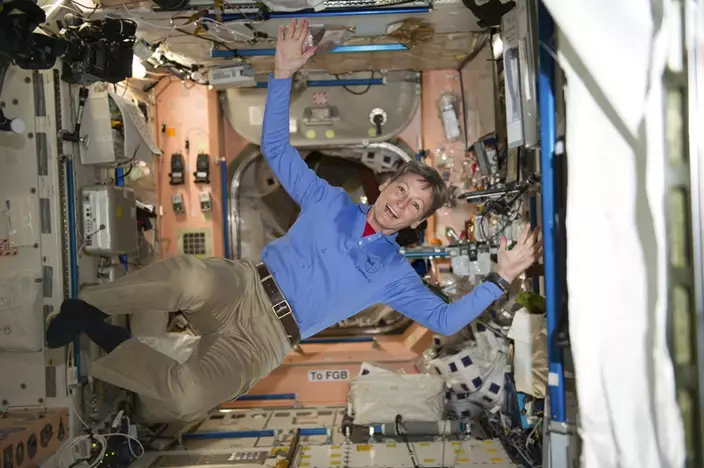
In this Nov. 28, 2016 photo made available by NASA, astronaut Peggy Whitson floats through the Unity module aboard the International Space Station. On Friday, June 15, 2018, NASA announced Whitson, who has spent more time off the planet than any other American, has retired. The 58-year-old biochemist joined NASA as a researcher in 1986 and became an astronaut in 1996. Her last spaceflight was in 2017. (NASA via AP)
Whitson was the first woman to command the International Space Station, holding the position twice, and the oldest woman ever to fly in space. She was also the only woman to have served as chief of NASA's male-dominated astronaut corps.
Fellow astronauts called her a "space ninja."
"It's been the greatest honor to live out my lifelong dream of being a @NASA Astronaut," Whitson said via Twitter, thanking "all who have supported me along the way."
"As I reminisce on my many treasured memories, it's safe to say my journey at NASA has been out of this world!"
The 58-year-old biochemist, who grew up on an Iowa hog farm, joined NASA as a researcher in 1986 and became an astronaut in 1996. Her last spaceflight, spanning 2016 and 2017, lasted close to 10 months.
Only Russian men have spent more time in space: Gennady Padalka holds the record with 879 days over five missions.
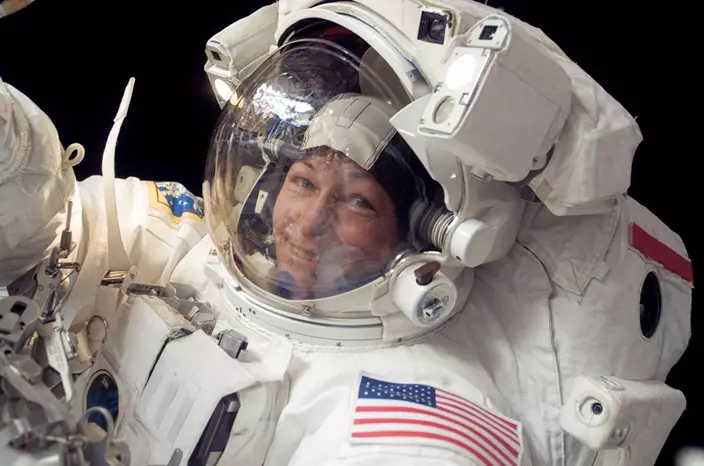
In this Jan. 30, 2008 photo made available by NASA, Expedition 16 commander Peggy Whitson, the first female commander of the International Space Station, participates in a spacewalk. On Friday, June 15, 2018, NASA announced Whitson, who has spent more time off the planet than any other American, has retired. The 58-year-old biochemist joined NASA as a researcher in 1986 and became an astronaut in 1996. Her last spaceflight was in 2017. (NASA via AP)
NASA Administrator Jim Bridenstine called Whitson an inspiration, citing her determination and dedication to science, exploration and discovery.
"She set the highest standards for human spaceflight operations," Brian Kelly, director of flight operations at Johnson Space Center in Houston, said in a statement, "as well as being an outstanding role model for women and men in America and across the globe."
Before leaving the space station last September, Whitson said she would miss the orbiting outpost — an "awe-inspiring creation" — and the views from 250 miles up.
"I will miss seeing the enchantingly peaceful limb of our Earth from this vantage point. Until the end of my days, my eyes will search the horizon to see that curve," she said.

In this Dec. 3, 2016 photo made available by NASA, astronaut Peggy Whitson poses for a photo in the cupola of the International Space Station, with the Earth in the background. On Friday, June 15, 2018, NASA announced Whitson, who has spent more time off the planet than any other American, has retired. The 58-year-old biochemist joined NASA as a researcher in 1986 and became an astronaut in 1996. (NASA via AP)
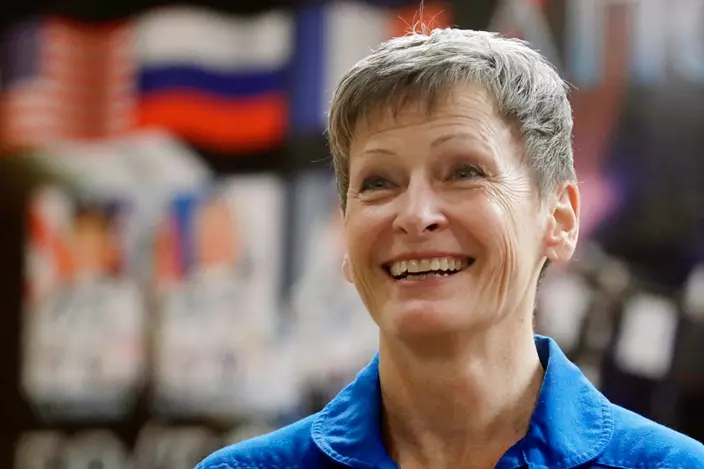
FILE - In this Nov. 16, 2016 file photo, U.S. astronaut Peggy Whitson, a member of the main crew to the International Space Station (ISS), speaks during a news conference in Russian leased Baikonur cosmodrome, Kazakhstan. On Friday, June 15, 2018, NASA announced Whitson, who has spent more time off the planet than any other American, has retired. The 58-year-old biochemist joined NASA as a researcher in 1986 and became an astronaut in 1996. Her last spaceflight was in 2017. (AP Photo/Dmitri Lovetsky)
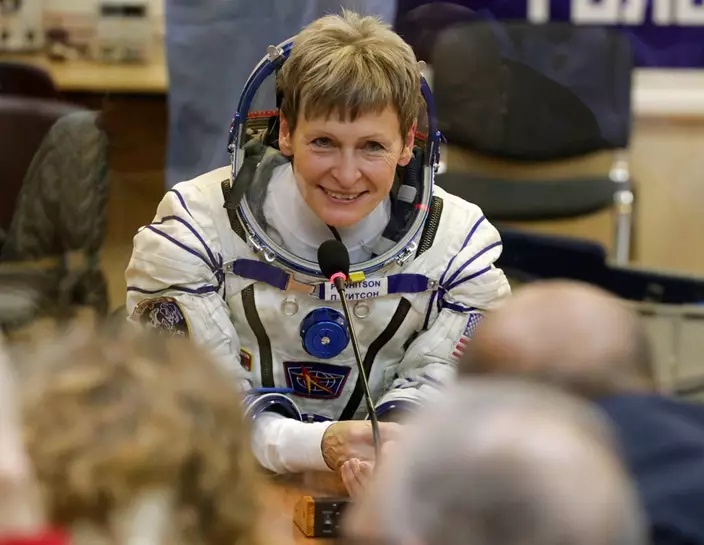
FILE - In this Nov. 17, 2016 file photo, U.S. astronaut Peggy Whitson, member of the main crew of the expedition to the International Space Station (ISS), speaks with her relatives prior the launch of Soyuz MS-3 space ship at the Russian leased Baikonur cosmodrome, Kazakhstan. On Friday, June 15, 2018, NASA announced Whitson, who has spent more time off the planet than any other American, has retired. The 58-year-old biochemist joined NASA as a researcher in 1986 and became an astronaut in 1996. Her last spaceflight was in 2017. (AP Photo/Dmitri Lovetsky, Pool)
UNITED NATIONS (AP) — Russia and Ukraine on Monday traded blame before the United Nations Security Council for the attacks on Europe’s largest nuclear power plant, which the head of the International Atomic Energy Agency said have put the world “dangerously close to a nuclear accident.”
Without attributing blame, IAEA Director General Rafael Mariano Grossi said his agency has been able to confirm three attacks against the Zaporizhzhia Nuclear Power Plant since April 7.
“These reckless attacks must cease immediately,” he told the Security Council. “Though, fortunately, they have not led to a radiological incident this time, they significantly increase the risk … where nuclear safety is already compromised.”
The remote-controlled nature of the drones that have attacked the plant means that it is impossible to definitively determine who launched them, Grossi told reporters after the meeting.
“In order to say something like that, we must have proof,” he said. “These attacks have been performed with a multitude of drones.”
Zaporizhzhia sits in Russian-controlled territory in southeastern Ukraine and has six nuclear reactors.
Fears of a nuclear catastrophe have been at the forefront since Russian troops occupied the plant shortly after invading in February 2022. Continued fighting between Russian and Ukrainian forces — as well as the tense supply situation at the plant — have raised the specter of a disaster.
Ukraine and its allies on Monday again blamed Russia for dangers at the site, with the United States saying, “Russia does not care about these risks.”
“If it did, it would not continue to forcibly control the plant,” U.S. deputy ambassador Robert Wood told the Security Council, which met at the initiative of the U.S. and Slovenia.
Russia, for its part, said Ukraine was to blame for the attacks.
“The IAEA’s report does not pinpoint which side is behind the attacks,” Russia’s U.N. Ambassador Vassily Nebenzia said. “We know full well who it is.”
“Over the last few months, such attacks not only resumed,” Nebenzia said, “they significantly intensified.”
Ukraine’s ambassador to the U.N., Sergiy Kyslytsya, called the attacks “a well-planned false flag operation by the Russian Federation,” which he alleged Russia had designed to distract the world from its invasion of its neighbor.
The Zaporizhzhia facility is one of the 10 biggest nuclear plants in the world. Fighting in the southern part of Ukraine where it is located has raised the specter of a potential nuclear disaster like the one at Chernobyl in 1986, where a reactor exploded and blew deadly radiation across a vast area.
Neither Russia nor Ukraine in recent months has been able to make significant advances along the 1,000-kilometer (620-mile) front line crossing eastern and southern Ukraine. Drones, artillery and missiles have featured heavily in what has become a war of attrition.
Russia and Ukraine have frequently traded accusations over the Zaporizhzhia plant.
The most recent strikes did not compromise the facility, which is designed to withstand a commercial airliner crashing into it, the IAEA said.
The plant’s six reactors have been shut down for months, but it still needs power and qualified staff to operate crucial cooling systems and other safety features.
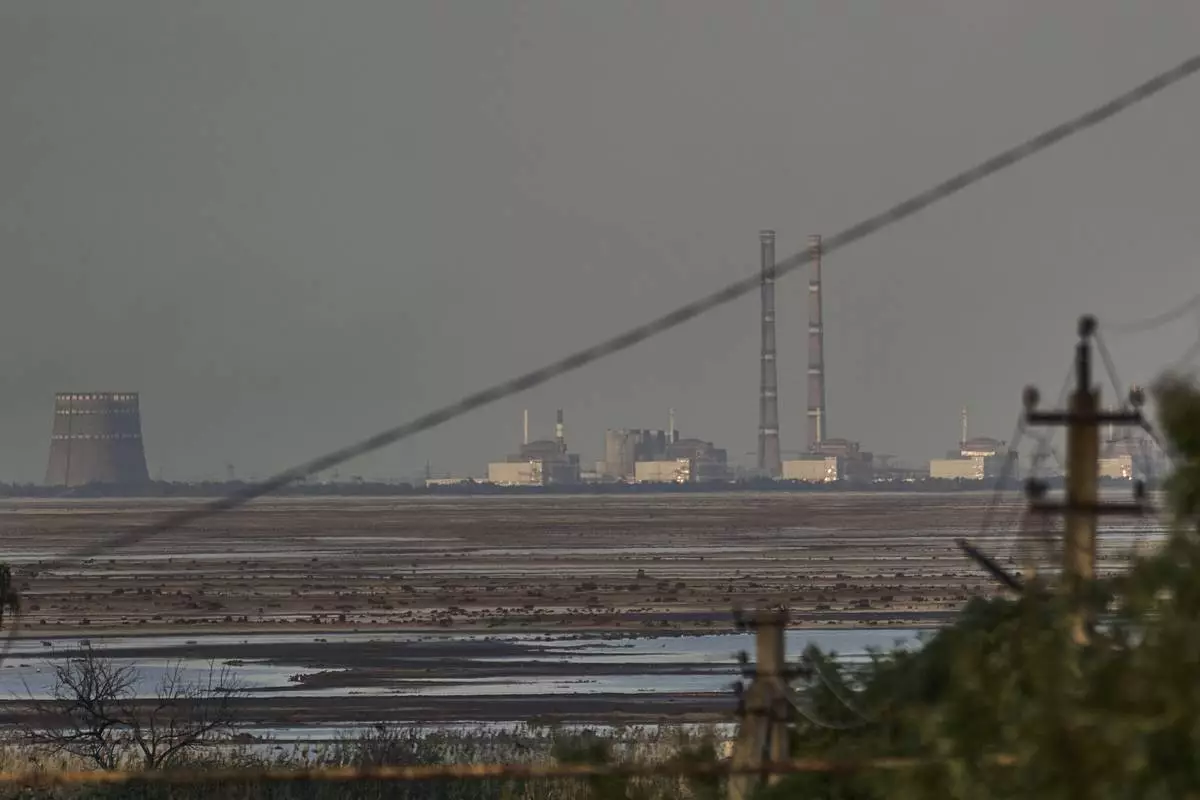
FILE - The Zaporizhzhia nuclear power plant, Europe's largest, is seen in the background of the shallow Kakhovka Reservoir after the dam collapse, in Energodar, Russian-occupied Ukraine, Tuesday, June 27, 2023. Officials at the Russian-controlled Zaporizhzhia Nuclear Power Plant said that the site was attacked Sunday April 7, 2024, by Ukrainian military drones, including a strike on the dome of the plant’s sixth power unit. (AP Photo/Libkos, File)
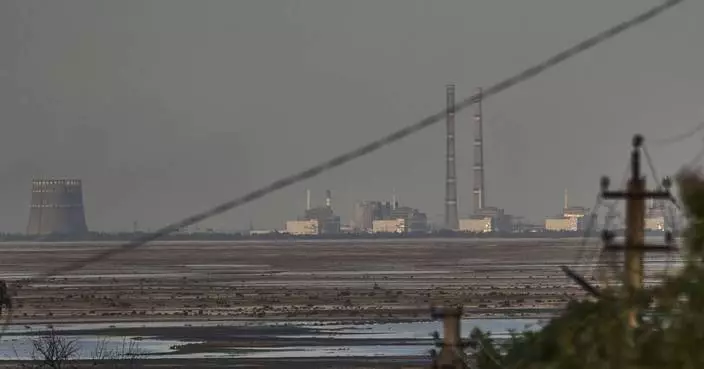
IAEA warns that attacks on a nuclear plant in Russian-controlled Ukraine put the world at risk
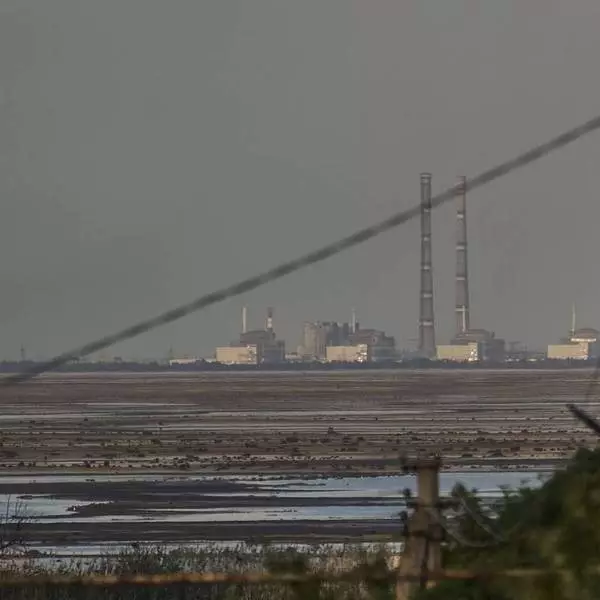
IAEA warns that attacks on a nuclear plant in Russian-controlled Ukraine put the world at risk











